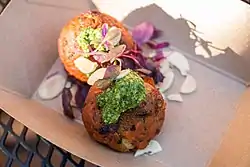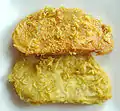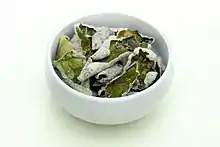Fritter
A fritter is a portion of meat, seafood, fruit, vegetables, or other ingredients which have been battered or breaded, or just a portion of dough without further ingredients, that is deep-fried.[1][2][3][4] Fritters are prepared in both sweet and savory varieties.[4]
 Carrot and chickpea fritters | |
| Main ingredients | batter or dough |
|---|---|
| Ingredients generally used | small pieces of meat, seafood, fruit, vegetables or other ingredient |
Definition
The 1854 edition of An American Dictionary of the English Language by Noah Webster defines fritter as a transitive verb meaning "to cut meat into small pieces to be fried".[5] Another definition from 1861 is given as "a pancake cont. chopped fruit, poultry, fish; also a small piece of meat fried".[6]
Varieties
Africa
West African countries have many variations similar to fritters. The most common process includes the blending of peeled black-eyed peas with peppers and spices to leave a thick texture. A Yoruba version, akara, is a popular street snack and side dish in Nigerian culture.
South Africa
Pumpkin fritters, served with cinnamon sugar at any time of day, are popular in South Africa.[7][8]
South Asia
Fritters are extremely popular roadside snacks all over South Asia and are commonly referred to as pakora (pakoda) or bhajji (bhajia) in local parlance—the onion bhaji also enjoys a high popularity abroad and at home.
India
In India, a pakora is a fritter of assorted vegetables and spices.
In the South Indian state of Kerala, banana fritters are extremely popular.
Piyaji is a Bengali dish of fritters with onions.
.jpg.webp) Chilli pakoras
Chilli pakoras Onion fritters (piyaji) is a Bengali dish made with onions.
Onion fritters (piyaji) is a Bengali dish made with onions. A woman making bajjis in Mylapore
A woman making bajjis in Mylapore Uggani bajji, rice and fritters, a typical breakfast in Rayalaseema
Uggani bajji, rice and fritters, a typical breakfast in Rayalaseema
Brunei
In Brunei, fritters are known as cucur and they are eaten as snacks. Cucur is also part of local street food and usually sold in street market-style food booth (locally known as gerai). They are usually made with fillings which are commonly made with banana, shrimp, yam, sweet potatoes and vegetables (usually sliced cabbages or carrots). Some local fruits, when they are in season, are also made into cucur, most commonly durian, breadfruit (sukun), tibadak (Artocarpus integer) and tarap (Artocarpus odoratissimus).
Indonesia
In Indonesia fritters come under the category of gorengan (Indonesian: fritters, from goreng "to fry"), and many varieties are sold on travelling carts or by street vendors throughout Indonesia.[9] Various kinds of ingredients are battered and deep-fried, such as bananas (pisang goreng), tempe mendoan, tahu goreng (fried tofu), oncom, sweet potato, cassava chunk, cassava tapai, cireng (tapioca fritters), bakwan (flour with chopped vegetables), Tahu isi (filled tofu), and breadfruit.[10] These are often eaten accompanied by fresh bird's eye chili. The variety known as bakwan commonly contains flour with chopped vegetables such as carrot and cabbage, whereas the fried patties called perkedel typically consist of mashed potatoes or ground corn (perkedel jagung or bakwan jagung).
 Gorengan, Indonesian street vendor of assorted fritters
Gorengan, Indonesian street vendor of assorted fritters
 Bakwan jagung, Indonesian corn fritter
Bakwan jagung, Indonesian corn fritter Fritter peddler offering pisang goreng, Indonesian banana fritter
Fritter peddler offering pisang goreng, Indonesian banana fritter
Malaysia
In Malaysia, it is common for a type of fritter called "cucur"[11] (such as yam, sweet potato and banana[12]) to be fried by the roadside[12] in a large wok and sold as snacks.
 Malaysian roadside yam and sweet potato fritters
Malaysian roadside yam and sweet potato fritters
Myanmar
In Burmese cuisine, fritters are called a-kyaw (Burmese: အကြော်), while assorted fritters are called a-kyaw-sone (Burmese: အကြော်စုံ). The most popular a-kyaw is the gourd fritter (ဘူးသီးကြော်). Diced onions, chickpea, potatoes, a variety of leafy vegetables, brown bean paste, Burmese tofu, chayote, banana and crackling are other popular fritter ingredients. Black beans are made into a paste with curry leaves to make bayagyaw[13]—small fritters similar to falafel. Unlike pisang goreng, Burmese banana fritters are made only with overripe bananas with no sugar or honey added.
The savory fritters are eaten mainly at breakfast or as a snack at tea. Gourd, chickpea and onion fritters are cut into small parts and eaten with Mohinga, Myanmar's national dish. These fritters are also eaten with Kao hnyin baung rice and with Burmese green sauce—called chin-saw-kar or a-chin-yay. Depending on the fritter hawker, the sauce is made from chili sauce diluted with vinegar, water, cilantro, finely diced tomatoes, garlic and onions.
 Fried snacks of Myanmar
Fried snacks of Myanmar
Philippines
In the Philippines, egg fritters are called tokneneng (duck) or kwek-kwek (quail), and squid fritters are called kalamares. These, along with shrimp fritters called okoy, and banana fritters called maruya are also sold in travelling cart or street side vendors.
Thailand
 Nam phrik kapi served with vegetable fritters; a common dish in Thai cuisine
Nam phrik kapi served with vegetable fritters; a common dish in Thai cuisine
China
Throughout China, fritters are sold at roadsides. They may contain pork, but are commonly vegetarian.
- A couple making fritters in Hainan, China. Each contains some fermented beans, chopped spring onion, and a small cube of pork meat. These sell for 5 mao (jiao), equivalent to around 8 US cents.
Japan
In Japanese cuisine, tempura is vegetable or seafood dipped and fried in a light crispy batter and served as a common accompaniment to meals.
Korea
In Korean cuisine, deep-fried foods are known as twigim (튀김). Twigim are often battered and breaded, but there are varieties without breading, as well as varieties without breading and batter. Popular twigim dishes include dak-twigim (fried chicken), gim-mari-twigim (fried seaweed roll), goguma-twigim (fried sweet potato), gul-twigim (fried oyster), ojingeo-twigim (fried squid), and saeu-twigim (fried shrimp).
Traditional vegetarian deep-fried foods associated with Korean temple cuisine include twigak and bugak.[14] Twigak are made from vegetables such as dasima (kelp) and bamboo shoot, without breading or batter. Bugak are made from vegetables such as dasima, perilla leaves, and chili peppers, which are coated with glutinous rice paste and dried thoroughly.


 Miyeok-twigak (seaweed fries)
Miyeok-twigak (seaweed fries)
Europe
United Kingdom
In British fish and chip shops, the fish and chips can be accompanied by "fritters", which means a food item, such as a slice of potato, a pineapple ring, an apple ring[16] or chunks, or mushy peas fried in batter. Hence: "potato fritter", "pineapple fritter", "apple fritter", "pea fritter", etc. At home and at school, fritters are also sometimes made with meat, especially Spam and corned beef. A fritter roll or roll and fritter is a potato fritter inside a bread roll, served with salt and vinegar.[17]
North America
Canada/ United States of America
The apple fritter is a common fritter in Canada and the United States. Commonly found in doughnut shops, it is typically made from a yeast dough made of flour, sugar, eggs, milk, butter or shortening, and baker's yeast. The dough is basically the same as a traditional Canadian/American doughnut dough. It is flattened out and rolled with chopped apples and cinnamon. It is then chopped up into small pieces then reformed. It then is cut into portions and left to rise before being deep-fried or fried immediately. After done frying, they are dipped in a vanilla flavored glaze. It is believed to have been created by Tim Hortons in 1964 as one of their two original pastry items along with the dutchie doughnut. There is also a quick bread version that can be found from recipes online. It is mainly in the United States of America and is typically made from flour, sugar, baking powder, chopped apples, cinnamon, milk and eggs. It is also deep-fried and dipped in vanilla glaze as the yeasted version. In 2020, McDonald's announced that they will be serving apple fritters along with two other pastry items all day.
Caribbean
Conch fritters are commonly prepared in The Bahamas.[18]
See also
- Acarajé – Deep fried bean cake
- Arancini – Italian snack food
- Beignet – Deep fried pastry
- Boortsog – Traditional fried dough food found in Central Asian and Middle Eastern cuisines
- Buñuelo – Fried dough ball
- Carimañola – South American meat-pie in a burrito-shaped yuca fritter
- Crab cake – American crab dish
- Croquette – Small breaded, deep-fried food
- Cuchifritos – Various fried foods prepared principally of pork
- Fishcake – Minced or ground fish or other seafood mixed with a starchy ingredient, and fried
- Fried dough foods
- List of doughnut varieties
- List of bread dishes
- List of deep fried foods
- Mandazi – Fried bread
- Mücver – Turkish fritter or pancake, made from grated zucchini
- Pholourie – Fried, spiced dough balls
- Potato pancake – Shallow-fried pancakes of grated or ground potato
- Vada – Category of savoury fried snacks from India
- Pakora – Spiced fritter from the Indian subcontinent(India and Paksitan
- Zalabiyeh – Deep-fried pastry common to West Asia and Indian subcontinent
- Kevum
References
- Grand Diplome Cooking Course. Taylor & Francis US. p. 58. Retrieved November 5, 2016.
- Co., Royal Baking Powder (2009). The Royal Baker and Pastry Cook. Wildside Press. p. 7. ISBN 978-1-4344-5495-9. Retrieved November 5, 2016.
- Gisslen, W. (2004). Professional Baking. Wiley. p. 189. ISBN 978-0-471-46427-3. Retrieved November 5, 2016.
- Shields, D.S. (2015). Southern Provisions: The Creation and Revival of a Cuisine. University of Chicago Press. p. 158. ISBN 978-0-226-14125-1. Retrieved November 5, 2016.
- An American Dictionary of the English Language. Harper. 1854. p. 431.
- Cooley, Arnold James (1861). Dictionary of English Language Exhibiting Orthography, Pronunciation and Definition of Words. W. and R. Chambers.
- "Pumpkin fritters (pampoenkoekies) | Rainbow Cooking". www.rainbowcooking.co.nz.
- "PUMPKIN FRITTERS". November 3, 2014.
- Kraig, Bruce; Sen, Colleen Taylor (2013-09-09). Street Food Around the World: An Encyclopedia of Food and Culture. ABC-CLIO. ISBN 9781598849554.
- Fauziah (2017-06-02). "Gorengan: Indonesia's Favorite Fried Snacks - Indoindians". Indoindians. Retrieved 2018-06-27.
- Musa, N. (2016). Amazing Malaysian: Recipes for Vibrant Malaysian Home-Cooking. Random House. p. 90. ISBN 978-1-4735-2366-1. Retrieved November 5, 2016.
- Albala, K. (2011). Food Cultures of the World Encyclopedia. Food Cultures of the World Encyclopedia. Greenwood. p. 161. ISBN 978-0-313-37626-9. Retrieved November 5, 2016.
- Marks, C.; Thein, A. (1994). The Burmese Kitchen: Recipes from the Golden Land. M. Evans. p. 35. ISBN 978-1-59077-260-7. Retrieved November 5, 2016.
- Koehler, Robert (2010). Korea Foundation (ed.). Traditional Food: A Taste of Korean Life. Korea Essentials. Vol. 4. Seoul: Seoul Selection. ISBN 978-1-62412-036-7. Retrieved 1 March 2018.
- Bloom, A.; Wechter, E.B. (2010). Fodor's New Zealand. Fodor's New Zealand. Fodor's Travel Publications. p. 53. ISBN 978-1-4000-0841-4. Retrieved November 5, 2016.
- Raffald, E. (1808). The experienced English house-keeper, consisting of near 800 original receipts. p. 118. Retrieved November 5, 2016.
- CHALMERS, TORI (31 January 2017). "Glasgow Food Delicacies You Might Not Have Heard Of". theculturetrip. The Culture Trip Ltd. Retrieved 20 July 2019.
- "Conch Fritters | Traditional Sea Snail Dish From The Bahamas | TasteAtlas". www.tasteatlas.com. Retrieved 2023-06-18.
External links
 Media related to fritters at Wikimedia Commons
Media related to fritters at Wikimedia Commons

_from_Vigan%252C_Philippines.jpg.webp)




